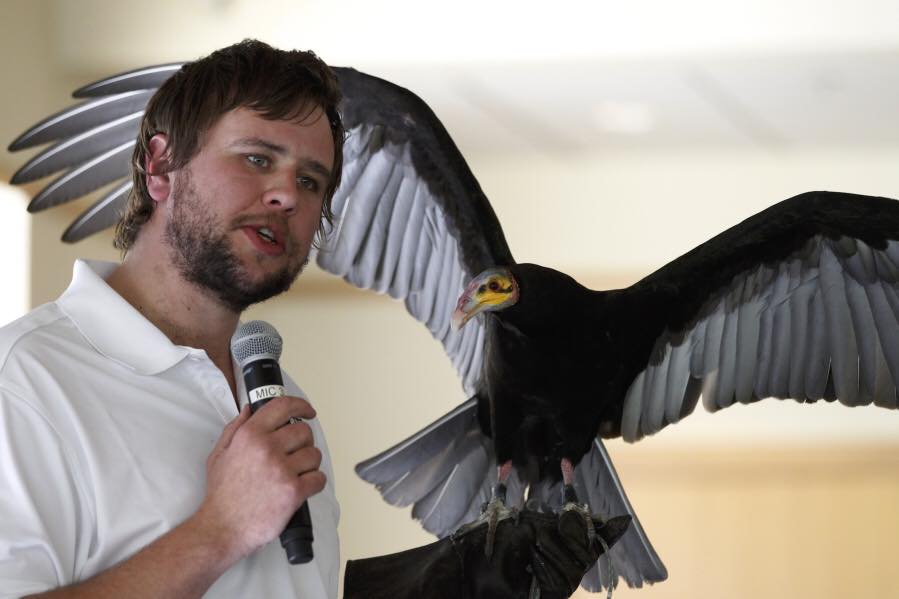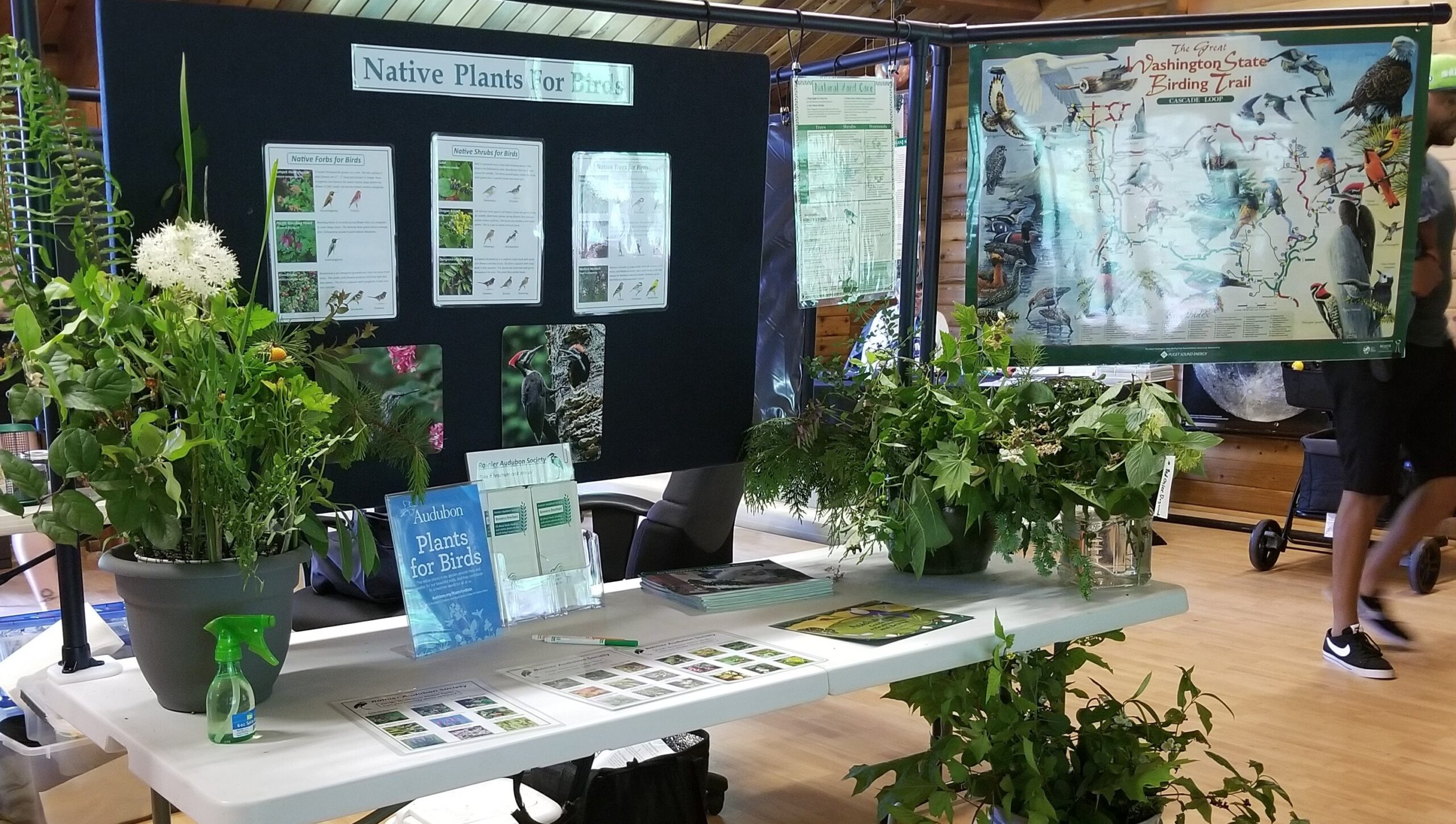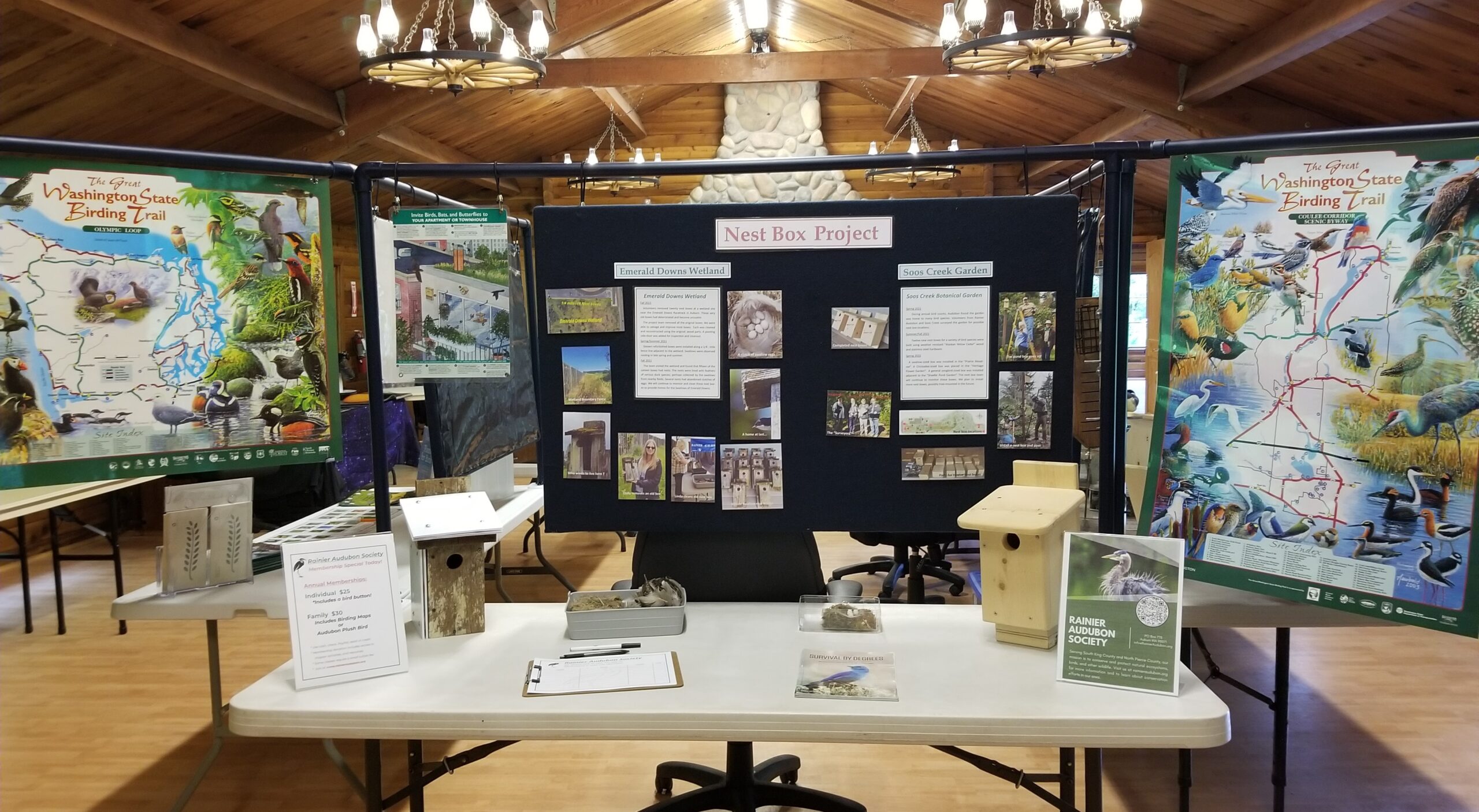
Seen and Heard: October 2021
by Calen Randall
“Rattattatt—Rattattatt”. As I write this article an early season storm is rumbling through the Puget Sound spreading downpours and strong winds around the region. The rain is a welcome sign after a dry summer, especially for the east side of the state which is currently mired in drought. Despite the drought and harsh semi-arid climate, ecosystems on the eastern side of the Cascades area are flush with birds. I got a chance to experience birding in the rain shadowed Oak Creek Wildlife Area of Yakima County back in June.
The drive along highway 12 between Packwood and Yakima is an enchanting mix of unique habitats, highlighting the myriad of biomes we have in Washington. The lush Douglas Fir forests on the rainy side of the Cascades gradually make way for Lodgepole Pines and meadows of the alpine zone at White Pass. As the terrain begins descending, the Lodgepoles transition to Ponderosa forests, home to many of our state’s secretive woodpecker species like the American Three-toed and White-headed Woodpeckers. Into the lowlands and along the Tieton River, the forests thin out and a random oak tree appears. Then another. Suddenly, the entire road is surrounded by oak trees. The sagebrush canyons are a pretty backdrop for the riparian oak forest nestled along the riverbanks.
The avian creatures of the river valley certainly add flourishes of colour. Licorice red, Halloween orange, and lazuli blue can all be found flitting about in the riparian zone. One of the more vibrant birds is the Lewis’s Woodpecker. Unlike their secretive higher elevation cousins, Lewis’s are flashy and abundant and favor open forests. Every few minutes there’s a flash of movement in the corner of your eye, and your eyes dart to yet another woodpecker, clad in green and red. Lewis’s have a kinglet-like knack for not standing still, but I managed to spot one meticulously caching nuts in an oak tree. Lewis’s Woodpeckers are defensive of their caches, especially with other woodpecker species looking to score a free acorn meal. As I watched the woodpeckers flap from tree to tree, it was apparent how well suited they are to their climate and habitat. Wildfires play an important role for Lewis’s Woodpeckers by thinning the pine forests. The charred snags and decaying trees leftover from the fires act as bedrooms and pantries alike, perfect for Lewis’s to nest in and cache their food.
Sunrise is a busy time of day for the birds at Oak Creek. The cool temperatures are far more bearable, and the copious supply of insects is abuzz. Flycatchers love the mornings, especially the Ash-throated Flycatcher. Chances are you will hear the sputtery chirps of this large flycatcher before spotting it perched in the canopy of the oak trees. Their ash-coloured throat and chest contrast with a yellow underbelly, and their primary wing feathers sport strips of cinnamon. They are very active, even when resting, and have some comical expressions. From the tree tops they peer down at you, quizzically tilting their head side-to-side like a dog, or bobbing their heads as though nodding in agreement. Oak Creek lies in the very northern extent of the Ash-throated Flycatcher’s range and in the fall they will head south to the Pacific coast of Mexico and Honduras. Few birds are more suited to the semi-arid desert environment than the Ash-throated Flycatchers. They don’t even need to drink water! Instead, they get ample liquids from the plethora of insects, spiders, and fruit that they eat. That’s a useful trait for living in the desert!
Lewis’s Woodpeckers and Ash-throated Flycatchers aren’t the only active and vocal birds along Oak Creek. “Chh-Chh-Chh-Cheew-Cheew” chortles the Bullock’s Orioles. A Yellow-breasted Chat peaks out from a snag as it belts out a cornucopia of sounds. You won’t need to stray from Oak Creek’s visitor center to find one of the noisier birds. The oak trees outside the visitor center bathrooms are home to a pair of Western Kingbird nests! They sputter and chirp back and forth between their woven cup nests. My favorite call is the descending trill and following cat-like mews of the Canyon Wren which echoes down the canyon. Tricky to spot against the rocky hillside, Canyon Wrens are defensive and a pair’s breeding territory can be as large as several acres. Not all Canyon Wrens are great neighbors. Recently, researchers in Arizona found that the wrens cause problems for White-throated Swifts roosting in the wren’s breeding territory. When the Canyon Wrens sing, the swifts may respond by calling loudly or even divebombing the wrens. Ironically, we also saw White-throated Swifts roosting near the singing Canyon Wrens. It would be interesting to see if the same swift-wren conflicts occur at Oak Creek too.
(Left) A Lewis’s Woodpecker caches a nut on a tree branch. (Center) An Ash-throated Flycatcher curiously eyes the pair of birders staring at it. (Right) A female Bullock’s Oriole ensures all rules are followed at the park.
Have you seen any interesting bird behavior lately? Send your sightings and interesting bird stories to me at calenbirds@hotmail.com!
Hotspot of the Month
72nd Ave Wetland Ponds, Kent, WA—Well known hotspots like the Kent Ponds (Green River Natural Resource Area), 204th Street, and Boeing Ponds garner most of Kent’s birding activity, but this new hotspot is worth a visit. Like most wetland hotspots, the habitat of the twin ponds ranges over the course of the year and provides a nice annual cycle of birding activity.
Currently, the ponds are grown in, but if you’re patient, you can spot a family of Green Herons hanging out on snags in the middle of the ponds. Want some practice identifying ducks? The twin ponds are home to over a dozen waterfowl species. As winter nears and pond vegetation decreases, you can get great views of their striking plumage. Even goldeneye and mergansers will visit from the nearby Green River! Spring showers coincide with an influx of shorebirds feeding in the brimming ponds. You might hear the “tew-tew-tew” whinnying squeaks of a Greater Yellowlegs or spot a Least Sandpiper skittering along the shallows. Even during the dog days of summer you can find Canada Geese, Mallards, and Hooded Mergansers raising their goslings and ducklings on the ponds.
Want to visit the ponds? You can find them between 220th and 216th Streets in Kent on 72nd Ave, just a half mile walk from the east entrance of Kent Ponds. If you love cycling and birds, you are in luck. The 72nd Ave ponds are accessible from the Interurban Trail. You might even spot a Green Heron while taking a water break! eBird Hotspot link: Kent–72nd Ave. Wetlands, King County, WA, US – eBird Hotspot
Recent Sightings
August 2021 Fall migration in the Puget Sound is marked by the passage of shorebirds including some who skip the area in the spring. Baird’s Sandpipers were sighted on the Enumclaw Plateau alongside Pectoral Sandpipers and Red-necked Phalaropes. It has been a particularly good year for phalaropes in the area with numerous sightings of Red-necks and Wilson’s Phalarope at M Street this past spring. Dozens of Black Turnstones and Surfbirds returned to the rocky shores of West Seattle and this year they were accompanied by a Wandering Tattler. Tattlers look similar to Surfbirds—they are both chunky grey shorebirds with speckled underbellies and yellow legs—however, there are some telltale differences. One clue is the bill. Tattlers have a noticeably longer bill, while the Surfbird’s is shorter and thicker. Both bills are dark with a path of yellow on the base of the mandible (lower bill). Tattlers also have a longer tail which they use when bobbing up and down repeatedly, like a Spotted Sandpiper. Surfbirds have a shorter tail and haven’t quite mastered the “bob your tail feather” move yet. If you get a really good view, you might spot a thin dark line running past the Tattler’s eye. No such band appears on the Surfbird’s head.
In late August, a Ruff made a week-long stop at the 16th Avenue retention ponds in Puyallup. You would be forgiven for confusing a male Ruff in breeding plumage with a Shakespearean actor, as his neck feather display is Elizabethan-esque, as the name suggests. Unfortunately, this immature Ruff was yet to earn its “ruff”, but it was still fascinating to observe. Its plumage was a light buff-colour, similar to a Buff-breasted Sandpiper, but back had a scaled or cross-hatched pattern like that of a Pectoral Sandpiper. Clearly something in the retention pond was tasty, as the young Ruff picked through the shallow water for over an hour as we watched.
Ruffs are normally found breeding in Eurasia and migrating to Africa and Australia, so this ruffless Ruff had to be one of the rarer retention pond sightings I’ve ever seen. Though rare, it isn’t unheard of for immature Ruff to be sighted in western Washington in August. A couple other immature Ruffs were spotted on the Skagit flats and Whidbey Island around the same time, all stocking up on food before a long cross-Pacific flight. That’s a lot of “frequent flyer” points!
September 2021 September is a tough time to be a Caspian Tern or a diminutive Bonaparte’s Gull. Hungry jaegars are back in the Puget Sound scouring the bays looking to snatch a snack from someone. Parasitic Jaegars are by far the most common and can be glimpsed prowling around Dumas Bay or Dash Point. Point Defiance is a great place to scope from with expansive views of Commencement Bay, Dalco Passage, and the East Passage. The open view makes it easier to see seabirds flying between the channels. In addition to the Parasitic Jaegars, typical pelagic dwellers Long-tailed Jaegar and Pomeraine Jaegar were spotted this September. Jaegars weren’t the only seabirds visiting the Sound during September, Common Terns were spotted hanging out on floating driftwood. The biggest pelagic surprise of the month, however, was a handful of Short-tailed Shearwaters. Like the jaegars, typically shearwaters are found migrating down the Pacific coast so to find multiple in the Puget Sound was certainly a surprise. Early one morning a quartet of Short-tails were glimpsed off the coast of Discovery Park. A few hours later birders at Point Defiance were delighted when four shearwaters swooped down past Dash Point and into Commencement Bay! Exciting times on the Sound!
Bio: After 22 years of searching in his backyard, Calen has yet to find his quest bird, the Blue-footed Booby. Currently a student in Atmospheric Science at the University of Washington, Calen has spent the last 11 years turning in overdue Seen and Heard articles. Calen loves exploring new regions of the Pacific Northwest, but always looks forward to returning home to familiar hotspots in the South Puget Sound






